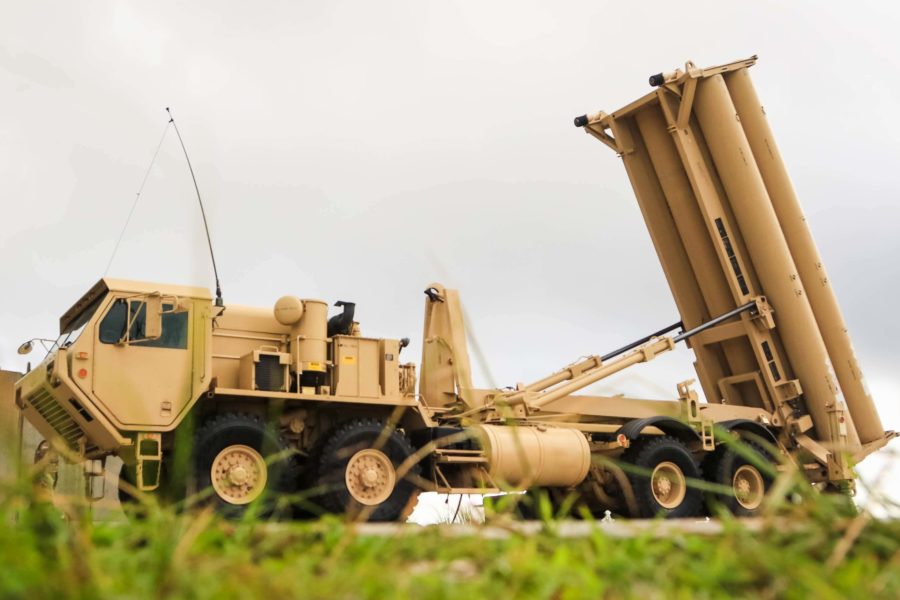The strategically important U.S. territory of Guam would get 360-degree sensor coverage, missile defenses, and a command center in a plan put forth in the Missile Defense Agency’s fiscal 2023 budget request.
MDA director Vice Adm. Jon A. Hill made the case for the array of new defensive systems during a May 23 event at the Center for Strategic and International Studies in Washington, D.C., after highlighting all the capabilities that would be located on the island if Congress approves the plan.
“Location does matter,” Hill said. “If you just go look at where Guam is on the map, it is inside an area that is absolutely tactically relevant,” Hill said of the Pacific island that is 2,500 nautical miles from mainland China and home to U.S. military installations including Andersen Air Force Base and Naval Base Guam with its Polaris Point Submarine Base.
“You’ve got repair facilities there. We’ve got the Marine Corps there. We’re going to be stationing long-range fires there. It needs to be defended,” Hill said.
He said Guam is not yet defendable against ballistic, cruise, or hypersonic missiles. The fiscal 2023 budget request, which is now before Congress, seeks to close that gap and to prepare Guam to be the most forward Pacific site in the defense of the U.S. homeland.
“If you were to pluck out the most important thing about what we’re going to do on Guam, it is going to be that command center,” Hill said.
The planning and budget for Guam answers the needs outlined by the commander of U.S. Indo-Pacific Command Adm. John Aquilino, he added.
Guam’s Command-and-Control Center
Hill considers the defense of Guam to be the MDA’s second-most-important priority behind homeland defense against ballistic missiles from rogue nations. MDA’s budget requests $539 million for architecture work and for design and development of multiple land-based radar systems and procurement of weapon system components.
“If you look at how you fight the battle in the INDOPACOM region today, it’s fairly dispersed in terms of command and control,” Hill explained. “So, you really need to have an area that brings in all the space and land-based and sea-based assets from a sensor perspective and fuses that data and then selects the appropriate way to go after it.”
Aquilino and his team will be part of the development process, ensuring that the command-and-control center is appropriately laid out for mature technologies and the technologies of the future.
Part of MDA’s vision is giving the INDOPACOM commander a single integrated air picture.
The Air Force already has the data streams, he said, and the command-and-control center will bring them together in a way that is operational to the warfighter.
“Yes, it is a challenge. I think it is the hardest thing we’re going to do, and that is the most important aspect about Guam,” Hill said. “You could talk about radars and launchers and weapons all day long, but if we don’t get command-and-control right, none of that will matter.”
Defense of Guam
Guam is currently protected by the Army’s Terminal High Altitude Area Defense (THAAD) ballistic missile defense systems and a Navy ship at sea providing forward defense.
Building on Guam’s layered defenses would add Patriot missile defenses to the THAAD battery and relieve the three to four Navy ships required on rotation for protection of the island.
“What MDA will do from a mission space perspective is leverage the Aegis fire control for ballistic missile attack and for hypersonics,” said Hill, referencing the SM-3 and SM-6 sea-based missiles now used for ballistic and hypersonic missile defense, respectively.
Patriots and THAAD would be part of an Integrated Air and Missile Defense Battle Command System (IBCS) along with Sentinel radars and Indirect Fire Protection Capability Increment (IFPC) missile interceptors.
“So, we’ve got it from top all the way to bottom in terms of that layered defense,” Hill said.
Finding sites for all the new military infrastructure remains a challenge for defending Guam. Only 27 percent of Guam’s land is available for use, Hill said, and all the services are competing for space.
The island is the size of the city of Chicago, and maintaining its beauty is vital to the tourism sector that forms its lifeline. But MDA has installed radars, interceptors, and missile systems while preserving the natural beauty of Hawaii and Alaska.
“When I say difficult, I’m talking about siting—the fundamentals of where you’re going to place this equipment,” Hill said. “I’m also talking about respecting the beautification of that island, right? We don’t want to go into a major tourist area and just overmilitarize.”
Likewise, an adversary can target static systems, so missile defense systems will be a modified version of current mobile offensive varieties. Likewise, studies are underway to determine if the command-and-control center will be made mobile.
“When I lay it out, in the end, I think it’s good for Guam to have that capability,” Hill said of the decision to go with mobile launchers, which have fewer missiles and add logistical considerations, such as fire control and reloading.
Hill said MDA is in the final stages of selecting some 19 sites to position assets, but defense of Guam can fully operationalize under the fiscal 2023 budget request.
“You’re going to have to deal with ballistic missiles. … You’re going to deal with cruise missiles, and you’re going to deal with hypersonic threats,” Hill said of the challenges of defending Guam. “So, that’s really what’s reflected in [the budget] is that sort of capability on the island because it deserves to be defended.”
